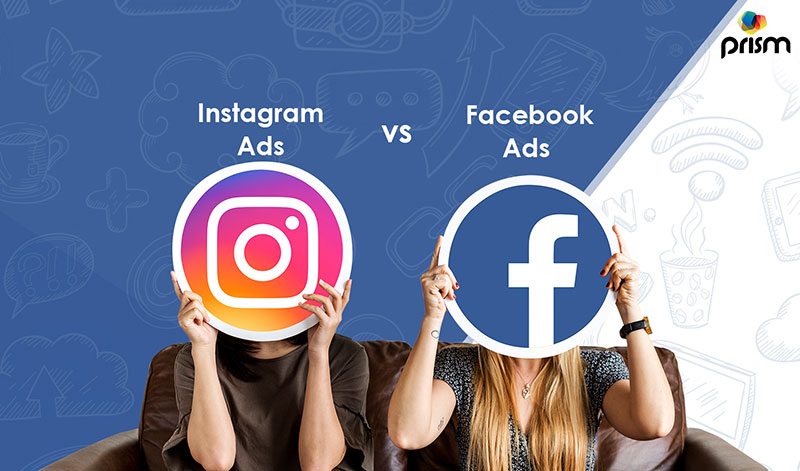

Facebook Ads vs Instagram Ads: Which Platform is Better?

Table Of Contents
- How to expand your social media audience by up to 25%?
- How to take advantage of Facebook and Instagram ad platforms?
- How to get insights into your audience's intent?
- Does industry play a role in your advertising success?
- How to create synergies amongst your organic efforts?
- What is the importance of setting goals for advertising?
- How to optimize resource allocation to optimize each platform?
Expand your audience by up to 25%.
75% of all Facebook users were also on Instagram as of January 2021. This means that running your Facebook advertisements on Instagram might increase your reach by up to 25%.
Due to the fact that this is an average, the real incremental reach may be lower. Use the Audience Size estimator tool to determine the size of the possible audience on each platform to ensure there is a significant reach gain.
It is not suggested to run on both Facebook and Instagram if the difference is less than 10%.
The great majority of customers on one platform may have already seen it on the other, and the minor incremental performance advantages are unlikely to warrant the effort on your part to manage and report on it.
Take advantage of each platform's unique ad formats
Instagram's ad layouts are still evolving, and certain e-commerce functionalities are now available. Despite this, Instagram is more of a destination for individuals searching for inspiration and ideas than for those trying to buy anything.
Meanwhile, unlike an Instagram ad, Facebook does not have the high-impact forms that would amaze a user.
If images are a foremost focus, consider solely running on Instagram, especially if you want to make a lasting impression.
Instagram is also the suggested first choice if a short-form video is utilized to boost engagement with the video.
For any "lower funnel" initiatives, Facebook is a preferable choice, especially for e-commerce or conversion-oriented campaigns where the transaction will take place on a different site outside of the portal.
Instagram users are more likely to be in the early stages of their decision-making process and prefer to stay within the portal.
Consider running on both platforms if your imagery is more utilitarian than emotive and boosting in-portal engagement (e.g., comments, shares) is more critical than off-portal visitor visits.
Get an insight of your audience's intent
When it comes to purpose, Facebook and Instagram users tend to slant in opposing directions, as mentioned before.
Users are attracted to each platform at various phases of the marketing funnel. Instagram, on the other hand, tends to encourage more upper-funnel activity, such as browsing and high interaction with visual ad assets
Users on Facebook, on the other hand, may buy things, sign up for things, and undertake a number of other transaction-related activities.
For upper-funnel audience initiatives, prioritize Instagram, while for lower-funnel efforts, prioritize Facebook. Run several campaigns across all platforms, but with distinct creative assets and language, to ensure that each effort is suited to the user intent at each of these stages.
If you're building a mid-funnel plan, using the same method for Instagram and Facebook is sufficient.
Consider your industry
Another factor to consider when deciding whether to advertise on Facebook or Instagram is your industry. Food, fashion, and trendy consumer goods are among the industries that thrive on Instagram for a reason.
If you already have accounts on both platforms, check your total social media statistics to determine which is generating the most organic sort of activity. Getting more Facebook clicks? Take it into consideration and produce an ad that resembles that sort of material.
The amount you spend on advertisements is also determined by the business you work in. More expensive items will require several advertisements to raise consumer awareness, encourage purchase consideration, and drive buyers along the marketing funnel.
If your sector does not have a big presence on the network, you may face less advertising competition and hence a cheaper cost. As a result, you'll need a little industry presence as well as a large target population to target the ad at.
If this does not exist, your ad will not perform since the audience is too tiny to get traction.
Personalize the content of the supporting text
Instagram is largely a visual social media platform. While viewers are used to reading some supporting text, Facebook is a preferable channel to employ when a lot of additional information has to be shared within the ad unit.
This includes not just any text contained inside the graphic, but also the text portion of the title and description boxes.
If only a little quantity of text is required, both systems can be used efficiently. However, if there are more than two phrases, individuals are more likely to read them on Facebook.
Create synergies amongst your organic efforts
Your ad will be connected with your profile – and, by extension, your organic feed – whether on Facebook or Instagram. Consider increasing organic engagement in the build-up to the sponsored social campaign if your organic feed has been inactive.
Paid adverts allow consumers to interact with you and view your organic profile.
Anyone who is unfamiliar with your company but is interested in learning more (due to your enticing ad) should go to your organic profile.
If they realize that the organic profile has had minimal activity, it will be a bad user experience.
Consider restricting your advertisements to only the platform with a stronger organic presence if your organic presence on either Facebook or Instagram isn't particularly strong.
Set quantifiable goals
Goal awareness is interwoven into practically every aspect of determining where to run your adverts. If you don't have specific goals in mind for your adverts, you should pause and consider this before proceeding.
You won't be able to assess KPIs, campaign performance, or even figure out the targeting you want until you have specific goals in place.
Facebook's Ad Manager makes goal selection simple by allowing you to specify your objective right away. Although not all of these choices are accessible on Instagram, this controls both Instagram and Facebook advertisements. You don't have a choice in the aim if you promote on Instagram via the app. Keep this in mind while you set your goals.
Brand awareness goals combined with attention-getting content would work effectively on Instagram. On the other hand, a goal like website clicks combined with a positive news or review piece might be more effective on Facebook.
Allocating Resources to Optimize Each Platform
While many reporting and setup tools are common between Facebook and Instagram, a thorough grasp of each platform is required for optimal performance and analysis of outcomes.
That necessitates having specialized resources with in-depth knowledge of each platform as well as the time to devote to its management. If this isn't the case for your team, focus on simply Facebook or Instagram instead of spreading your efforts too thin.
The added concentration will pay off in terms of optimization depth, which would be compromised if the same team had to work on two platforms at the same time.
As Meta develops, more ad types and capabilities will undoubtedly arise. Keep an eye out for updates and use these factors to determine if you should run on both Facebook and Instagram or concentrate your efforts just on one.
Don't be scared to experiment with various sorts of content and objectives while serving the same audience. In Facebook Ads Manager, an A/B test is offered for this purpose. Experimentation is a logical avenue to follow once you have some great performing advertising in place.
The flexibility to adjust ads while they are running is a benefit of both systems. Is a campaign spending too much money? Reduce the volume or cut it short. Is one sort of material better than another in terms of audience engagement? Put an end to the ad that isn't working.
Success in social media marketing requires a combination of strategy, research, and a little luck. Your plan from a year ago may no longer be effective now, and the same can be said for the future.
This might interest you as well: How do I use Facebook audience insights for better targeting?
Furthermore, the networks' algorithms and advertising features are continually being tweaked. It wouldn't be shocking if Instagram's targeting choices grew to resemble those of Facebook, or if additional Instagram-specific ones were introduced.
We recommend understanding what it takes to run a successful Instagram ad campaign and double-checking your Facebook advertising plan for a more in-depth look at both networks.
This is it for today’s blog. I hope you enjoyed reading it and that you’ve learned a thing or two about social advertising. Feel free to reach out to me if you have any questions and I will get back to you as soon as possible.
If you are a business owner with no time to focus on digital advertising, contact Prism Digital, the best advertising agency in Dubai and our experts will create and manage advertising strategies that will bring in results for your business. See you on the other side. Thank you.

About The Author: Lovetto Nazareth
Lovetto Nazareth is a digital marketing consultant and agency owner of Prism Digital. He has been in the advertising and digital marketing business for the last 2 decades and has managed thousands of campaigns and generated millions of dollars of new leads. He is an avid adventure sports enthusiast and a singer-songwriter. Follow him on social media on @Lovetto Nazareth
Post Your Comment!
Recent Blogs
Digital Dominance: Why do you need a Top Web Development Agency in Dubai?
Dominate Search Engines with Top-Tier PPC Management Dubai in 2025
Top Video Production Companies in Dubai – 2025
Mobile-First Indexing: How To Optimize Your Website For The Future

Support
Phone: +971 55 850 0095
Email: sales@prism-me.com
Location: Prism Digital Marketing Management LLC Latifa Tower, Office No. 604 - West Wing World Trade Center 1, Sheikh Zayed Road Dubai, UAE
Subscribe
Join our newsletter to stay up to date on features and releases.
By subscribing you agree to our Privacy Policy and provide consent to receive updates from our company.
